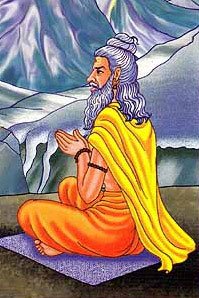Parameshthina, Parameṣṭhina: 4 definitions
Introduction:
Parameshthina means something in Hinduism, Sanskrit. If you want to know the exact meaning, history, etymology or English translation of this term then check out the descriptions on this page. Add your comment or reference to a book if you want to contribute to this summary article.
The Sanskrit term Parameṣṭhina can be transliterated into English as Paramesthina or Parameshthina, using the IAST transliteration scheme (?).
In Hinduism
Purana and Itihasa (epic history)
Source: JatLand: List of Mahabharata people and placesParameṣṭhina (परमेष्ठिन) is a name mentioned in the Mahābhārata (cf. I.89.28) and represents one of the many proper names used for people and places. Note: The Mahābhārata (mentioning Parameṣṭhina) is a Sanskrit epic poem consisting of 100,000 ślokas (metrical verses) and is over 2000 years old.

The Purana (पुराण, purāṇas) refers to Sanskrit literature preserving ancient India’s vast cultural history, including historical legends, religious ceremonies, various arts and sciences. The eighteen mahapuranas total over 400,000 shlokas (metrical couplets) and date to at least several centuries BCE.
Languages of India and abroad
Sanskrit dictionary
Source: Cologne Digital Sanskrit Dictionaries: Monier-Williams Sanskrit-English DictionaryParameṣṭhina (परमेष्ठिन):—[=parame-ṣṭhina] [from parame > para] = -ṣṭhin, [Atharva-veda xix, 9, 4.]
[Sanskrit to German]
Sanskrit, also spelled संस्कृतम् (saṃskṛtam), is an ancient language of India commonly seen as the grandmother of the Indo-European language family (even English!). Closely allied with Prakrit and Pali, Sanskrit is more exhaustive in both grammar and terms and has the most extensive collection of literature in the world, greatly surpassing its sister-languages Greek and Latin.
See also (Relevant definitions)
Partial matches: Parame.
Full-text: Bhutartha, Paryushana, Parameshthin, Shlagh, Stuti, Vyahriti, Bhuta.
Relevant text
Search found 7 books and stories containing Parameshthina, Parameṣṭhina, Paramesthina, Parame-shthina, Parame-ṣṭhina, Parame-sthina; (plurals include: Parameshthinas, Parameṣṭhinas, Paramesthinas, shthinas, ṣṭhinas, sthinas). You can also click to the full overview containing English textual excerpts. Below are direct links for the most relevant articles:
Cidgaganacandrika (study) (by S. Mahalakshmi)
Verse 191 [Necessity of external object for reflection disproved] < [Chapter 4 - Fourth Vimarśa]
Garga Samhita (English) (by Danavir Goswami)
Verse 3.1.8 < [Chapter 1 - The Worship of Śrī Girirāja]
Chaitanya Bhagavata (by Bhumipati Dāsa)
Verse 2.16.124 < [Chapter 16 - The Lord’s Acceptance of Śuklāmbara’s Rice]
Brihadaranyaka Upanishad (by Swāmī Mādhavānanda)
Section VI - The Line of Teachers < [Chapter IV]
Section VI - The Line of Teachers < [Chapter II]
Rudra-Shiva concept (Study) (by Maumita Bhattacharjee)
40. Pañcabrahma incarnation < [Chapter 5 - Rudra-Śiva in the Purāṇic Literature]
2. Physical appearance of Śiva < [Chapter 5 - Rudra-Śiva in the Purāṇic Literature]
Brihad Bhagavatamrita (commentary) (by Śrī Śrīmad Bhaktivedānta Nārāyana Gosvāmī Mahārāja)
Verse 2.2.96 < [Chapter 2 - Jñāna (knowledge)]